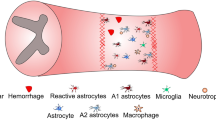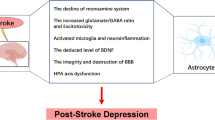Abstract
Humanin (HN) has been proved to be an extensive neuroprotective peptide against AD-related and unrelated insults, but little is know about the effect of HN in inflammation response. Current studies indicated the receptors of HN have a close relationship with immune system, which led us to hypothesize HN might have a role in inflammatory response. In this study, we used lipopolysaccharide (LPS) to induce astrocyte inflammation response. This model in vitro allowed us to study the effect of HN on the pure response of astrocyte without the exogenous influence between cells in vivo. Our results showed that 1.0 μg/ml LPS induced a significant activation of astrocyte, shown as the marked increase in the glial fibrillary acidic protein (GFAP) expression, the cell viability and the number of 5-bromo-2′-deoxyuridine (BrdU)-positive living cells. Pretreatment with HN (5, 10, 20 μM) led to a significant inhibition in astrocyte overactivation in a concentration dependent manner. We also found pretreatment with HN decreased the level of proinflammatory cytokines, interleukin (IL)-6, IL-1β and tumor necrosis factor α (TNFα) induced by LPS. Furthermore, we noticed HN couldn’t completely reverse the above inflammatory injury. Our findings imply that HN partly antagonizes inflammation injury induced by LPS and the protective effect of HN on astrocyte is concentration-dependent.



Similar content being viewed by others
References
Hashimoto Y, Niikura T, Tajima H, Yasukawa T, Sudo H, Ito Y, Kita Y, Kawasumi M, Kouyama K, Doyu M, Sobue G, Koide T, Tsuji S, Lang J, Kurokawa K, Nishimoto I (2001) A rescue factor abolishing neuronal cell death by a wide spectrum of familial Alzheimer’s disease genes and Abeta. Proc Natl Acad Sci USA 98(11):6336–6341. doi:10.1073/pnas.10113349898/11/6336
Kariya S, Takahashi N, Hirano M, Ueno S (2003) Humanin improves impaired metabolic activity and prolongs survival of serum-deprived human lymphocytes. Mol Cell Biochem 254(1–2):83–89
Sponne I, Fifre A, Koziel V, Kriem B, Oster T, Pillot T (2004) Humanin rescues cortical neurons from prion-peptide-induced apoptosis. Mol Cell Neurosci 25(1):95–102. doi:10.1016/j.mcn.2003.09.017
Ying G, Iribarren P, Zhou Y, Gong W, Zhang N, Yu ZX, Le Y, Cui Y, Wang JM (2004) Humanin, a newly identified neuroprotective factor, uses the G protein-coupled formylpeptide receptor-like-1 as a functional receptor. J Immunol 172(11):7078–7085
Yazawa H, Yu ZX, Le Takeda Y, Gong W, Ferrans VJ, Oppenheim JJ, Li CC, Wang JM (2001) Beta amyloid peptide (Abeta42) is internalized via the G-protein-coupled receptor FPRL1 and forms fibrillar aggregates in macrophages. FASEB J 15(13):2454–2462. doi:10.1096/fj.01-0251com
Hashimoto Y, Kurita M, Aiso S, Nishimoto I, Matsuoka M (2009) Humanin inhibits neuronal cell death by interacting with a cytokine receptor complex or complexes involving CNTF receptor alpha/WSX-1/gp130. Mol Biol Cell 20(12):2864–2873. doi:10.1091/mbc.E09-02-0168
Taga T, Kishimoto T (1997) Gp130 and the interleukin-6 family of cytokines. Annu Rev Immunol 15:797–819. doi:10.1146/annurev.immunol.15.1.797
Fischer P, Hilfiker-Kleiner D (2008) Role of gp130-mediated signalling pathways in the heart and its impact on potential therapeutic aspects. Br J Pharmacol 153(Suppl 1):S414–S427. doi:10.1038/bjp.2008.1
Li C, Zhao R, Gao K, Wei Z, Yin MY, Lau LT, Chui D, Hoi Yu AC (2011) Astrocytes: implications for neuroinflammatory pathogenesis of Alzheimer’s disease. Curr Alzheimer Res 8 (1):67–80
Tajima H, Niikura T, Hashimoto Y, Ito Y, Kita Y, Terashita K, Yamazaki K, Koto A, Aiso S, Nishimoto I (2002) Evidence for in vivo production of Humanin peptide, a neuroprotective factor against Alzheimer’s disease-related insults. Neurosci Lett 324(3):227–231
Bodzioch M, Lapicka-Bodzioch K, Zapala B, Kamysz W, Kiec-Wilk B, Dembinska-Kiec A (2009) Evidence for potential functionality of nuclearly-encoded humanin isoforms. Genomics 94(4):247–256. doi:10.1016/j.ygeno.2009.05.006
Gallo V, Ciotti MT, Coletti A, Aloisi F, Levi G (1982) Selective release of glutamate from cerebellar granule cells differentiating in culture. Proc Natl Acad Sci USA 79(24):7919–7923
Zhao ST, Chen M, Li SJ, Zhang MH, Li BX, Das M, Bean JC, Kong JM, Zhu XH, Gao TM (2009) Mitochondrial BNIP3 upregulation precedes endonuclease G translocation in hippocampal neuronal death following oxygen-glucose deprivation. BMC Neurosci 10:113. doi:10.1186/1471-2202-10-113
Zhao ST, Huang XT, Zhang C, Ke Y Humanin protects cortical neurons from ischemia and reperfusion injury by the increased activity of superoxide dismutase. Neurochem Res 37(1):153–160. doi:10.1007/s11064-011-0593-0
Eng LF, Ghirnikar RS (1994) GFAP and astrogliosis. Brain Pathol 4(3):229–237
Dong Y, Benveniste EN (2001) Immune function of astrocytes. Glia 36(2):180–190. doi:10.1002/glia.1107
Muzumdar RH, Huffman DM, Calvert JW, Jha S, Weinberg Y, Cui L, Nemkal A, Atzmon G, Klein L, Gundewar S, Ji SY, Lavu M, Predmore BL, Lefer DJ (2010) Acute humanin therapy attenuates myocardial ischemia and reperfusion injury in mice. Arter Thromb Vasc Biol 30(10):1940–1948. doi:10.1161/ATVBAHA.110.205997
Bachar AR, Scheffer L, Schroeder AS, Nakamura HK, Cobb LJ, Oh YK, Lerman LO, Pagano RE, Cohen P, Lerman A (2010) Humanin is expressed in human vascular walls and has a cytoprotective effect against oxidized LDL-induced oxidative stress. Cardiovasc Res 88(2):360–366. doi:10.1093/cvr/cvq191
Rolls A, Shechter R, Schwartz M (2009) The bright side of the glial scar in CNS repair. Nat Rev Neurosci 10(3):235–241. doi:10.1038/nrn2591
Bal-Price A, Brown GC (2001) Inflammatory neurodegeneration mediated by nitric oxide from activated glia-inhibiting neuronal respiration, causing glutamate release and excitotoxicity. J Neurosci 21(17):6480–6491
Eng LF, Ghirnikar RS, Lee YL (2000) Glial fibrillary acidic protein: GFAP-thirty-one years (1969–2000). Neurochem Res 25(9–10):1439–1451
Liedtke W, Edelmann W, Bieri PL, Chiu FC, Cowan NJ, Kucherlapati R, Raine CS (1996) GFAP is necessary for the integrity of CNS white matter architecture and long-term maintenance of myelination. Neuron 17(4):607–615
Messing A, Goldman JE, Johnson AB, Brenner M (2001) Alexander disease: new insights from genetics. J Neuropathol Exp Neurol 60(6):563–573
Sriram K, Benkovic SA, Hebert MA, Miller DB, O’Callaghan JP (2004) Induction of gp130-related cytokines and activation of JAK2/STAT3 pathway in astrocytes precedes up-regulation of glial fibrillary acidic protein in the 1-methyl-4-phenyl-1,2,3,6-tetrahydropyridine model of neurodegeneration: key signaling pathway for astrogliosis in vivo? J Biol Chem 279(19):19936–19947. doi:10.1074/jbc.M309304200
Maccioni RB, Rojo LE, Fernandez JA, Kuljis RO (2009) The role of neuroimmunomodulation in Alzheimer’s disease. Ann NY Acad Sci 1153:240–246. doi:10.1111/j.1749-6632.2008.03972
Rojo LE, Fernandez JA, Maccioni AA, Jimenez JM, Maccioni RB (2008) Neuroinflammation: implications for the pathogenesis and molecular diagnosis of Alzheimer’s disease. Arch Med Res 39(1):1–16. doi:10.1016/j.arcmed.2007.10.001
Del Bo R, Angeretti N, Lucca E, De Simoni MG, Forloni G (1995) Reciprocal control of inflammatory cytokines, IL-1 and IL-6, and beta-amyloid production in cultures. Neurosci Lett 188(1):70–74
Sparkman NL, Buchanan JB, Heyen JR, Chen J, Beverly JL, Johnson RW (2006) Interleukin-6 facilitates lipopolysaccharide-induced disruption in working memory and expression of other proinflammatory cytokines in hippocampal neuronal cell layers. J Neurosci 26(42):10709–10716. doi:10.1523/JNEUROSCI.3376-06.2006
Griffin WS, Liu L, Li Y, Mrak RE, Barger SW (2006) Interleukin-1 mediates Alzheimer and Lewy body pathologies. J Neuroinflamma 3:5. doi:10.1186/1742-2094-3-5
Wang Q, Tompkins KD, Simonyi A, Korthuis RJ, Sun AY, Sun GY (2006) Apocynin protects against global cerebral ischemia-reperfusion-induced oxidative stress and injury in the gerbil hippocampus. Brain Res 1090 1:182–189. doi:10.1016/j.brainres.2006.03.060
Acknowledgments
This work was supported by National Natural Science Foundation of China (No. 81100986), Medical Research Foundation of Guangdong Province (No. B2011135), Research Foundation of Education Bureau of Guangzhou (No. 10A154) and Breeding Project of Guangdong Province (No. LYM11105).
Conflict of interest
The authors declare that they have no competing interests.
Author information
Authors and Affiliations
Corresponding author
Rights and permissions
About this article
Cite this article
Zhao, ST., Zhao, L. & Li, JH. Neuroprotective Peptide Humanin Inhibits Inflammatory Response in Astrocytes Induced by Lipopolysaccharide. Neurochem Res 38, 581–588 (2013). https://doi.org/10.1007/s11064-012-0951-6
Received:
Revised:
Accepted:
Published:
Issue Date:
DOI: https://doi.org/10.1007/s11064-012-0951-6




